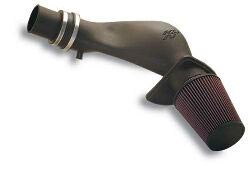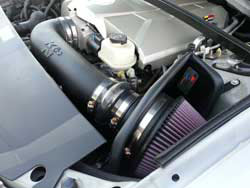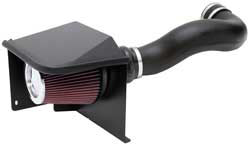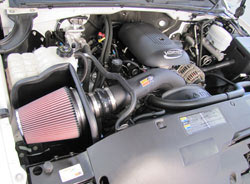GM Generation III LS Series Engine Air Intake Systems from K&N
- 12 Aug 2016
The General Motors Generation III engine series (often referred to as the LS engines) was designed to be manufactured in a range of different displacements so that it could be utilized in a variety of passenger cars and light trucks. It debuted in the 1997 model year C5 Corvette as the all-aluminum 5.7 L LS1 V8. For the following model year the LS1 replaced the LT1 350 CID small-block in Firebirds and Camaros. After which, an iron-block version of the Gen III V8 appeared in full size light trucks and SUVs. The Gen III was an all-new design with little more than the bore spacing in common with the original Chevrolet small block V8, first introduced in 1955, though its architecture was clearly influenced by the earlier design. The Gen III engine was smaller and lighter, it made more horsepower per cubic inch, created fewer emissions, and got better fuel mileage than the Chevy 350 it replaced. Changes like a new firing order made the Gen III engine run smoother than its predecessor, individual coils for each spark plug meant that ignition could be optimized by cylinder, rotating mass was decreased for faster revving and a host of other changes that not only made the Gen III more powerful than the LT1 350 small block, but also out-perform some four-valve DOHC engines. We've selected five versions of the Gen III engine to examine. These aren't all the highest performing versions, but rather provide an overview of how widespread the integration of the Gen III engine was across almost all GM nameplates and how adding a K&N intake to them can help bring your power numbers up.
Gen III LS1When introduced in the 1997 Corvette, the LS1 was rated at 345 horsepower. After ongoing development changes to the intake and exhaust manifolds raised output to 350 horsepower in 2001. The aluminum block LS1 was original equipment in the Corvette from 1997 through 2004. After one year of exclusivity in the Corvette, the Gen III motor replace the 350 small block in the 1998 through 2002 Pontiac Firebird Formula, Trans Am, and Chevrolet Camaro (GM F Body) cars, which produced up to 325 horsepower. K&N make filters for all LS1 applications. For example, K&N air intake system 57-3010-1 installed in a 1997 Camaro LS1 (without Ram Air or Traction Control) adds an estimated 18.3 rear-wheel horsepower at 5331 rpm. Applications:
Gen III LS6If you like the LS1, then you probably love the LS6. The LS6 was a high-performance version of the LS1 engine that retained the same 5.7 L displacement. Changes included a higher flow rate intake manifold and MAF-sensor, a new camshaft with higher lift and longer duration, an increased compression ratio of 10.5:1, sodium filled valves, and an oiling system better suited to high cornering speeds. The initial 2001 LS6 produced 385 horsepower, but was upgraded in the 2002 model year (through 2004 models) to produce 405 horsepower. A 400 horsepower version of the LS6 was available in the Cadillac CTS -V in 2004 and 2005. The LS6 shares its basic architecture with the GM LS1 engine, but other design changes were made such as windows cast into the block between cylinders, improved main web strength and bay to bay breathing, an intake manifold and MAF-sensor with higher flow, a camshaft with higher lift and more duration, a higher compression ratio of 10.5:1, sodium filled valves, and a revised oiling system better suited to high lateral acceleration. A 57-3054 K&N air intake system can add even more power to your LS6 powered CTS-V. K&N's chassis dyno testing showed an estimated increase of 19.1 rear-wheel horsepower over a stock Caddy. Applications: Gen III LR4Going from the LS6 to the LR4 is a bit like going from wild to mild, but the LR4 demonstrates the incredible versatility GM engineers designed into the Gen III family of engines. The LR4, more popularly known as the Vortec 4800 is a Generation III small block V8 engine specifically for truck applications. Displacement is 4.8 L (293 CID) with a slightly over-square configuration combining a 3.78 inch bore with a 3.27 inch stroke. The replacement for the 5.0L 5000 L30, the LR4 is the smallest of the Generation III truck engines. When introduced in 1999, the LR4 engine produced 255 horsepower while the 2000 through 2004 models produced 270-285 horsepower, based on application. For the 2005-2006 model years output was further increased to 285 horsepower, about the same SAE Net output as a 1969 Camaro Z/28. If you're looking for Z/28 like performance for your 2006 Chevy Tahoe consider the K&N 57-3050 air intake system which has been proven on K&N's chassis dynos to add an estimated nearly 12 additional rear-wheel horsepower at 5367 rpm. LR4 applications:
Gen III LM7The 5.3L LM7 V-8 was the first application of the Gen III/LS engine configurations available in a light truck. Specific modifications included a lighter valvetrain for reduced friction and increased efficiency, a steel camshaft reduced mass while maintaining truck-grade durability, steel roller rockers were added for stiffness, allowing for higher engine speeds with reduced vibrations. Hydraulic roller lifters reduced friction for better fuel economy and wear resistance, while the Iridium-tipped OEM spark plugs extend claimed plug life to 100,000 miles, while the coolant maintains its properties for 150,000 miles. Scheduled maintenance was limited to oil changes. The LM7 was introduced in the 1999 Chevrolet Silverado and GMC Sierra, where the engine produced 270 horsepower. Refinements to the design resulted in the 2000-2003 engines producing 285 horsepower. For the final versions, available from 2004 through 2007, the LM7 engine produced 295 horsepower, no doubt aided by the addition of aluminum cylinder heads. There were several variations of the LM7 made available. In 2002, the L59 was produced, which was the flexible fuel version of the LM7. Then in 2003 the LM4 became available, which was the LM7 with an aluminum engine block, making the engine all-aluminum (block and heads). Finally, in 2005, the L33 was first offered which was also an aluminum block and had other piston/cylinder head options that enabled more power creation. These Gen III versions of the small block remained available until 2007, when they were phased out. With its outstanding balance of torque, horsepower, fuel efficiency, low maintenance and low cost of ownership made the most widely applied of GM Powertrain's Vortec V-8s. And its performance can be improved further, like with the 2007 GMC Sierra 1500, which when fitted with the K&N air intake system 57-3058 added an estimated 17.6 rear wheel horsepower on K&N's chassis dynamometer. LM7 applications:
Gen III LQ4Like the LM7, the Gen III LQ4 was developed specifically as an engine for light trucks and SUVs. Commonly referred to as the Vortec 6000, it was one of the most popular of all the Gen III engines. Its displacement is 5.97 L or 364 CID from a 4.00-inch bore and a 3.622-inch stroke. It features a cast iron block with aluminum cylinder heads. The only exception was the 1999 and 2000 model year engines which featured cast iron heads. The LQ4 produces 300 horsepower to 325 horsepower, depending upon application. Other features shared with the LM7 include a steel camshaft, steel roller rockers, Iridium spark plugs, and long-life coolant. K&N can help you add hauling power to your LQ4. For example, a K&N 57-3031-1 air intake system added an estimated 20.3 rear-wheel horsepower to a 2006 Chevy Silverado 2500 HD. Applications: If you didn't see your vehicle listed here, fear not. K&N makes air filters, air intake systems, oil filters, car air conditioning air filters, and more for most of the vehicles on the road. Just use the K&N Search by Vehicle tool to find what we make for your vehicle. |
||||
|
||||













